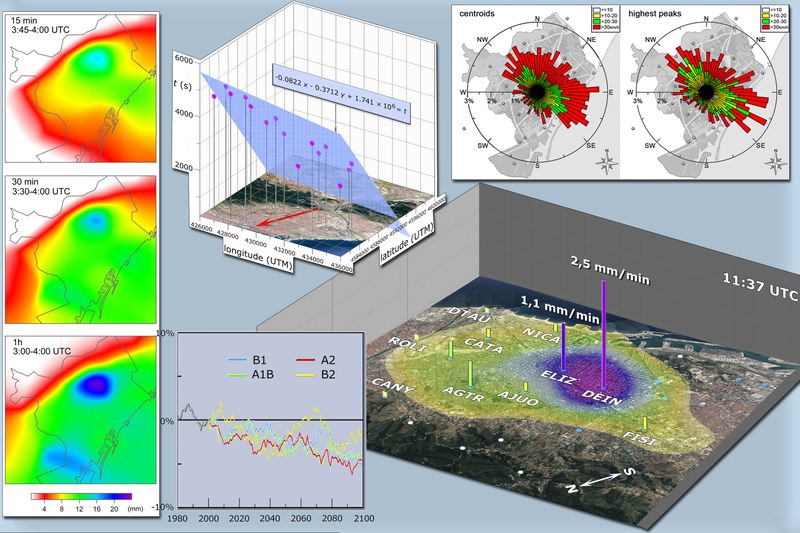Xavier Navarro Bosque defends his thesis on the spatial and temporal organization of rain in the metropolitan area of Barcelona
Mar 18, 2022
Xavier Navarro Bosque defended his thesis co-directed by Raül Rodríguez Solà and M. Carmen Casas Castillo on March 17 at the Vilanova i la Geltrú Campus. Titled "Spatial and temporal organization of rain in the metropolitan area of Barcelona", the thesis presents a complete study on rain in the city of Barcelona that includes the updating of its intensity-duration-frequency curves and the its areal reduction factors, the kinematic monitoring of storms over the city, and the possible effects of climate change on extreme intensities.
The spatial and temporal organization of the intensity of rainfall in Catalonia is very complex, even on a small scale such as in the metropolitan area of Barcelona, especially in episodes of heavy rain. Knowledge of its main features is of great importance from a meteorological point of view and in many applications, such as the issue of urban drainage. Currently, the most accurate and reliable way to obtain this information is from data provided by dense networks of intensity rain gauges. The metropolitan area of Barcelona, covering an area of approximately 100 km2, has a network of around twenty high-resolution tipping bucket rain gauges that has been operational since 1994, managed until 2013 by the company Clavegueram of Barcelona SA (CLABSA), and currently for Barcelona Cicle de l'Aigua S.A. (BCASA).
Based on the analysis of the temporality of the urban rainfall network records, the recurrence of intense storms in the area has been estimated, and the intensity-duration-frequency relations of the city have been updated; these are curves that provide information related to the origin and evolution of the meteorological situation that causes precipitation, and that are of great interest in the field of urban hydrology. One of the most important objectives of sewer networks is to evacuate the runoff of rainfall in urban areas as quickly as possible, in order to avoid dangerous conditions for pedestrians and vehicles on the surface, to avoid material damage, and to allow, in general, the normal development of the citizen activities. Therefore, in order to design these networks and to assess the risks, having accurate relations of intensity-duration-frequency of rainfall is essential. It is also interesting to know the spatial attenuation of rainfall intensities with distance; another result of this thesis has been the updating of the areal reduction factors of the city, corrective factors that are used to infer the equivalent amount over an area from rainfall recorded at one point.
Along the same lines of contributing to better management of the city's drainage systems to prevent surface flooding, a storm tracking study has been carried out, analysing the storms movement and evolution over the urban area of Barcelona, presenting a catalogue of the different situations observed during the years of study. In the case of intense rainfall, the movement of the rain cells has observed to be predominant in the E-SE direction, that is, towards the coast. A second group of cells that move towards the N-NE has also been found, compatible with a certain channelling effect produced by the Collserola mountain range, almost parallel to the coastline. More than 80% of the detected speeds range between 2 and 15 m/s.
The effects of climate change on hydrology due to a possible future intensification of the hydrological cycle must be considered in order to prevent future problems in urban drainage systems. The intensity-duration-frequency curves could be altered due to a possible increase in heavy rainfall caused by climate change. Simulations for the 21st century using climate models predict significant declines in total precipitation in the Mediterranean area, while some projections of regional models show a possible increase in torrential rainfall, with shorter and more intense precipitation episodes. These results indicate a change in the future climate, with a substantial reduction in episodes of light or moderate rainfall and, in turn, an increase in episodes of heavy rainfall. In this thesis, future series of daily precipitation in the metropolitan area of Barcelona have been projected and analysed under four scenarios of climate change, until the end of the s. XXI, and the changes to be expected in the future of the current curves of intensity-duration-frequency of the city have been estimated.

Share: